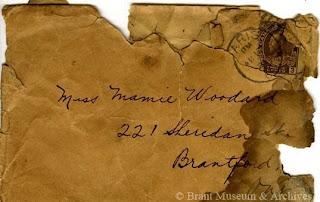 |
| Envelope, in poor condition, dated 1921 |
Imagine if an email or text message of yours could end up in a museum 90 years from now. What would researchers find? What sort of little things do you mention to friends on a daily basis? If my text messages from this past week were to be uncovered, people would see quick messages from my mum before she caught a flight home, giving directions to a colleague, and texting a friend back and forth about getting together to make peach jam (it's canning season, after all).
But digital communication is so ephemeral. What will future generations know about us and how we communicated? We (most of us anyways) don't print off our text messages. What clues will future people have when they are conducting their own research? We're fortunate to have letters, a form of communication which has mostly fallen by the wayside excepting for business and sometimes legal reasons. Letters are lovely. They are solid, physical pieces that can be examined for the kinds of clues and hints that researchers love.
This letter, addressed to Miss Mamie Woodard and dated summer 1921, was one of the very first things I catalogued when I started working at the Brant Museum & Archives as a summer student a few years back. I was so charmed by the little note (which is in fact several pages long) I spent some extra time researching the details and carefully scanning the pieces for our digital database.
Check into the BHS blog every week: we'll be releasing new pages of this letter in a 6-part series along with transcriptions and research notes.
In the meantime, do the future a favour: send a couple letters, and maybe keep a few of the letters and cards you receive for later generations. And for goodness sakes, put a date on them!
- Carlie
No comments:
Post a Comment